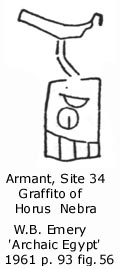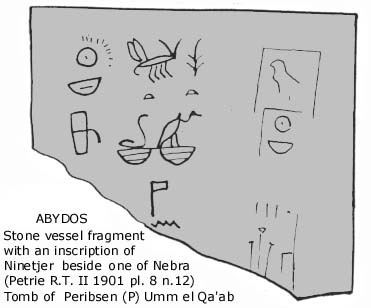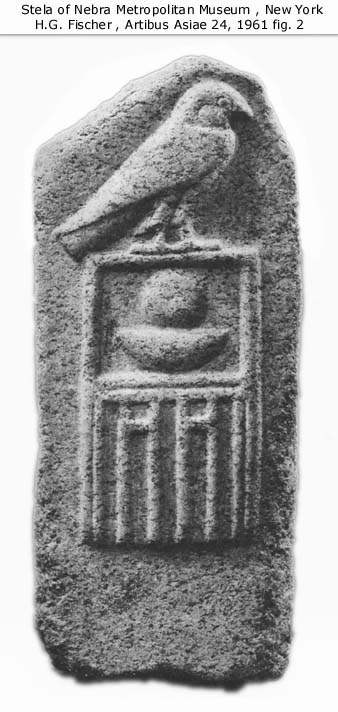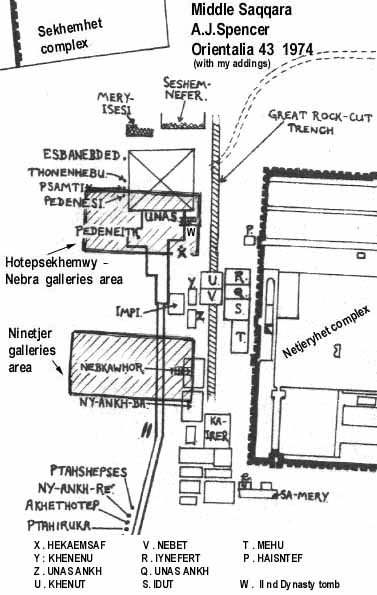.
NEBRA - (KAKAW
?)
.
The succession of the first half of the second dynasty (Hotepsekhemwy-Nebra-Ninetjer)
is out of doubts.
Nebra's reign proximity with the ones of Hotepsekhemwy and
Ninetjer is proved by different sources, first of all the findings
from the middle Saqqara tomb A and the inscription on the statuette
of Redjit (once incorrectly called Hotepdief).
Names
The Horus name Nebra is attested on a memphite stela, Cairo
CG 1 statuette, cylinder seals impressions, rock-graffitos .
Sometimes it's spelled 'Raneb' but this would imply the meaning
of '(The god) Ra is (my) Lord' whereas, being Ra yet unknown as a god
in this early period, the more probable meaning is with a direct genitive
'Lord of the sun' thus spelled 'Nebra' (Wilkinson 1999 p. 84; but cf. J. Kahl, in preparation).
The birth name reported by later King lists is univoquely
KAKAW*(Saqqara-Tjuloy tomb-list n. 4; Abydos-Sethi temple-list
n. 10, Turin Canon 2,21) also very similar to the Manetho Kaiechos
(Africanus) and Kaichoos (Eusebius); Manetho adds the note that
during his reign 'the Apis bull in Memphis and the Mnevis
bull in Heliopolis as well as the goat of Mendes were worshipped
as gods'. The Africanus reign length -39 years- is surely
too long ; a period of circa 10-15 years is more likely.
On the memphite Annals (Palermo stone, Cairo stone and related
fragments), according to the reconstruction of the wall from
which the known pieces come, the reign of Nebra should be in
the fifth line (which began on the right with Hotepsekhemwy
's reign) ending about 6 year compartments before the section
of Ninetjer' s reign preserved on the Palermo stone. All the
reconstructions agree with a c. 39 years total for the reigns
of Hotepsekhemwy + Nebra but the precise subdivision of the
two periods can only be guessed: from a 29+10 to a 19+19 all
the internal variations are possible but the shorter reign of
Nebra (10 years) seems to me more verisimilar than an equal
reign lenght of 19 years for the two kings. (Helck M.D.A.I.K.
30,1974 p.31; id.'Thinitenzeit' 1987 p.125; Kaiser Z.A.S. 86,1961
p.39; Barta Z.A.S. 108,1981 p.11; text in Schafer 'Ein Bruchstuck
Altagyptischer Annalen' ). *(Helck-Z.A.S. 106, 1979 reads the
name 'KAW' not 'Kakaw').
We must also mention that Gunn (in A.S.A.E. 28 p.152) proposed
the association of the name Nwbnefer
(in two inscriptions on Djoser's complex stone vessels) with
Nebra' s neswt-bity; but since the two names have never been
found together we must be careful in accepting this hypothesis
and think Nebra's neswt-bity might be a possible Kakaw or a
completely different name; Nwbnefer can't be the neswt-bity
name of Neferkaseker (already a neswt-bity) and should thence
be another ephemeral king of the period post-Ninetjer and pre-Khasekhem;
but the 'Hwt Menet-'Ankh' recurring in both the Pyr.Deg. IV
inscriptions (n.99 and 100) also appears once again in an inscription
dated to Ninetjer (Nwb Rn): this led Helck to consider Nwbnefer
a close successor of Ninetjer (and he placed the former after
Wng and Sened) but it could be better fitting if Nwbnefer was
the (yet unknown if we disregard the later (?) Kakaw) nswt-bity
name of Nebra, Ninetjer's immediate predecessor. If this was
the case Kakaw couldn't be the nswt-bity anymore and its origin
would in turn become a problem. (See Nwbnefer
page)
Finally according to a recent theory proposed by J. Kahl (»Ra is my Lord«. Searching for the Rise of the Sun God at the Dawn of Egyptian History, Wiesbaden, 2007, 12ff.) on the basis of the identification of superimposed inscriptions on the vessel shard London, BM
EA 35556, Horus Raneb's Nswtbity Nebty would be WeNeG (cf.); therefore the latter wouldn't be Ninetjer's follower but his predecessor.
 Objects The stela (see fig.) now in Metropolitan Museum of
Art (acc. 60.144) was bought by this museum in 1960; it came
from the Memphite area (Mit Rahina or the Middle Saqqara necropolis)
and was published by H.G. Fischer in 1961 (cfr. bibl.). The
rock is red granite, its size cm. 99 x 41 and,albeit the missing
upper part,it can be reconstructed as a round topped stela.
A later article by J.P. Lauer (see bibl.1966) tried to reaffirm
the royal character of the Saqqara necropolis of thinite period
: one of the various arguments in favour of Abydos as the thinite
kings burial site was the lack of royal stelas in the Saqqara
mastabas, and the Nebra stela could then challenge this point;
but the royal belongings of the Saqqara A and B tomb, as IInd
dynasty kings sepulchres has always been acknowledged whereas
the object of debate was the mastabas field on the border of
the north-east escarpment (now almost unanimously considered
an highest elite tombs cemetery).
The statuette Cairo CG 1
(Redjit once called Hotepdief) is discussed and shown in the
Hotepsekhemwy page.
The seal impressions(I.A.F.
3 fig. 264,294,295,296,367) have been found in the tomb A south
the Djoser's temenos south wall (cfr. Hotepsekhemwy page for
discussion and images), while inscriptions on Djoser's complex
stone vessels with Nebra name ere only three (Pyr. Deg. IV,1
pl.VI,3,4 and 11,58) plus an unprovenanced one (Kaplony, Steingefasse
35,16) and an
Objects The stela (see fig.) now in Metropolitan Museum of
Art (acc. 60.144) was bought by this museum in 1960; it came
from the Memphite area (Mit Rahina or the Middle Saqqara necropolis)
and was published by H.G. Fischer in 1961 (cfr. bibl.). The
rock is red granite, its size cm. 99 x 41 and,albeit the missing
upper part,it can be reconstructed as a round topped stela.
A later article by J.P. Lauer (see bibl.1966) tried to reaffirm
the royal character of the Saqqara necropolis of thinite period
: one of the various arguments in favour of Abydos as the thinite
kings burial site was the lack of royal stelas in the Saqqara
mastabas, and the Nebra stela could then challenge this point;
but the royal belongings of the Saqqara A and B tomb, as IInd
dynasty kings sepulchres has always been acknowledged whereas
the object of debate was the mastabas field on the border of
the north-east escarpment (now almost unanimously considered
an highest elite tombs cemetery).
The statuette Cairo CG 1
(Redjit once called Hotepdief) is discussed and shown in the
Hotepsekhemwy page.
The seal impressions(I.A.F.
3 fig. 264,294,295,296,367) have been found in the tomb A south
the Djoser's temenos south wall (cfr. Hotepsekhemwy page for
discussion and images), while inscriptions on Djoser's complex
stone vessels with Nebra name ere only three (Pyr. Deg. IV,1
pl.VI,3,4 and 11,58) plus an unprovenanced one (Kaplony, Steingefasse
35,16) and an
 example on a bowl from the complex of Menkaura at Giza (Reisner, Mycerinus
pl.70c).
Two rock graffitos near Armant
bear this king's serekh : one in Armant site 34 (fig ->)
in the western desert and another at site 40 in the eastern
desert (Winkler) (cfr. Wilkinson E.D.E. p.168,173). Only the
site 34 graffito undoubtely shows the Nebra name, the other
one is more erased; finally a steatite plaque with his name
was found by Quibell at El Kab
(1898) in the stairway tomb n.2 (Wilkinson, op.cit. 333).
Stone vessels inscriptions example on a bowl from the complex of Menkaura at Giza (Reisner, Mycerinus
pl.70c).
Two rock graffitos near Armant
bear this king's serekh : one in Armant site 34 (fig ->)
in the western desert and another at site 40 in the eastern
desert (Winkler) (cfr. Wilkinson E.D.E. p.168,173). Only the
site 34 graffito undoubtely shows the Nebra name, the other
one is more erased; finally a steatite plaque with his name
was found by Quibell at El Kab
(1898) in the stairway tomb n.2 (Wilkinson, op.cit. 333).
Stone vessels inscriptions
 <- The inscription on the stone vessel from the tomb of Peribsen
at Umm el Qa'ab (P) has been interpreted as an usurpation of
a Nebra' s vessel by Ninetjer, but the right hand side could
also have been naturally worn. The 'ra-neb' sign on the upper
left side has nothing to do with the king's name being perhaps
an indication of the priests' daily purification. The signs
under the Nebra serekh could be the royal estate 'Hwt za Ha
neb' known from the end of the Ist dynasty. Another estate of
king Nebra is on a seal impression
from the Saqqara tomb of Hotepsekhemwy-Nebra (Maspero A.S.A.E.
3, 1902) (cfr. fig. n. 264) but the reading (Ti-wa) is very
uncertain.
Another vessel inscription of the Horus Ninetjer (Pyr.Deg.
IV n. 68) names the Hwt Pe-Hor-Msn of the Horus Nebra(subject
of the verb 'shedet' ; on a similar inscription (Pyr. Deg. IV
n.58) of the reign of Hotepsekhemwy (there's the goddess Bastet)
the Horus name of Nebra has been added. Apart from these examples
no other stone vessel has Nebra's name incised onto (if we consider
the two examples of Nwbnefer cited above as of a distinct king).(See
Nebra's name on Stone Vessels and
Stone vessels series). <- The inscription on the stone vessel from the tomb of Peribsen
at Umm el Qa'ab (P) has been interpreted as an usurpation of
a Nebra' s vessel by Ninetjer, but the right hand side could
also have been naturally worn. The 'ra-neb' sign on the upper
left side has nothing to do with the king's name being perhaps
an indication of the priests' daily purification. The signs
under the Nebra serekh could be the royal estate 'Hwt za Ha
neb' known from the end of the Ist dynasty. Another estate of
king Nebra is on a seal impression
from the Saqqara tomb of Hotepsekhemwy-Nebra (Maspero A.S.A.E.
3, 1902) (cfr. fig. n. 264) but the reading (Ti-wa) is very
uncertain.
Another vessel inscription of the Horus Ninetjer (Pyr.Deg.
IV n. 68) names the Hwt Pe-Hor-Msn of the Horus Nebra(subject
of the verb 'shedet' ; on a similar inscription (Pyr. Deg. IV
n.58) of the reign of Hotepsekhemwy (there's the goddess Bastet)
the Horus name of Nebra has been added. Apart from these examples
no other stone vessel has Nebra's name incised onto (if we consider
the two examples of Nwbnefer cited above as of a distinct king).(See
Nebra's name on Stone Vessels and
Stone vessels series).
The Tomb A (Saqqara)
The Saqqara galleries under the Unas complex have been discussed
in the page of Hotepsekhemwy.
Here we will only rehearse that the attribution to Hotepsekhemwy,
since few years preferred by most of the scholars, seems to
be turning to the Nebra' s period in later years.
There are four possibilities :
1) Nebra usurped the tomb wholly built by Hotepsekhemwy
2) Nebra usurped the (unfinished) tomb initiated for Hotepsekhemwy
and he ended its building.
3) Nebra was buried elsewhere and the seal impressions mean
that he finished that burial for his predecessor or only presided
at the funerary ceremony of him (as for Qaa-Hotepsekhemwy and
Khasekhemwy-Netjeryhet at Abydos).
4) Nebra only built that tomb and he put into it some objects
which belonged to his predecessor .
The stratigraphy of this monument is poorly known and later
burials have also made it worse .
But the Hotepsekhemwy date has always been preferred because
the vastness of the subterreanean parts fits better with a long
reign : the material we have from Hotepsekhemwy's reign is more
numerous than the Nebra's thus it has been hypothesizedized
that the latter reign must have been shorter than his predecessor's
one; only Hotepsekhemwy might have had enough time to complete
such a monumental tomb. But this could be an incorrect conclusion
and the two kings, whose cumulative regnal years should have
been of almost 40 years (cfr. supra), could also have reigned
20 years each.
I think that, although the scanty amount of Nebra's objects
found could be the effect of chance, the statistical and comparison
analysis tends to be proportionally balanced so that we generally
have much more objects from longer reigning kings and less or
very few (if none at all) from short reigning or ephemeral kings.
(i.e. Nineter,Khasekhemwy vs Wneg,Sened,Nwbnefer)
Thus I maintain my opinion that the tomb was built by Hotepsekhemwy,
whose reign length must have been almost double than Nebra'
s (circa 19 years + 10 years).
Other scholars (Stadelmann) have pointed out the certain second
dynasty date of the galleries under all the western side of
the Djoser's complex at Saqqara; not less than 3 different sets
of galleries are cut in the tender rock of that area from the
west half of the northern court, through the central 'western
massif' to the southern galleries which are only 50 m from the
tomb A .
The longest central set could be by Khasekhemwy (but no findings
proves this) but there could also be works by the poorly known
kings of the middle of the dynasty or by the own Nebra.
Alternatively other galleries could be placed south of the
Hotepsekhemwy and Ninetjer' s ones in a unexcavated area covered
with sand east of Sekhemhet' s pyramid.
To conclude, we can say that the scarce evidence doesn't allow us to form a good picture of this reign, which must perhaps have been of c. 5-10 years long.
Instead there is some speculation which can be put forward about the particular character of royal names and titles of this dynasty kings, many of which are only faint shadows in the long history of the ancient Egypt. Indipendently from the correct reading of the name of the present ruler, the sun religion seems to be "conquering land" in this age [royal names and titles: Horus Neb-Ra, Nswtbity-Nebty Wneg, Seth-Ra Peribsen, Netjerykhet Ra-nwb... not to mention the NK lists and later alterations (?) of IInd-IIIrd Dynasty royal teophorous names which are reported to be formed with the name of 'RA': Neferkara, Nebkara].
These facts, united with the beginning of "bad times" at the end of Dynasty 1 and onward (Hotepsekhemwy's name, as the one of Khasekhemwy, should have been echoing that situation), cannot be 'translated' by us into certain history, but are perhaps enough to suggest that some sort of troubles must have been undergone by the state then (yet maybe nothing like a kind of "civil war" between followers of Horus and Seth or of South and North, as was once advanced).
These difficulties were overcome -although far from definitively- with the end of the reign of Khasekhemwy and the one of Djoser/Netjerykhet: the links with royal predecessors were emphasized in various manners ("collections" of stone vessels with royal inscriptions, legitimation of the holy blood through the female line, presentiating and organizing the dead king's funerary ceremonies and burial, edification of majestic monumental royal tombs and complex). Before the splendour of the 'great pyramids age' there was another dark period of few decades (mid-late 3rd Dynasty) after which the apogee of the classical period could truly begin. [Cf. for the Second Dynasty the recent paper of D. Gould, 2003].
Thus the roots of the mysterious religious (and undoubtedly political) problems (?) which ended up in Peribsen's "sethian heresy", seem to lie or to start to emerge in the early half of the 2nd dynasty, if not at the end of the previous one.
But, until now, it has proved to be still an impossible task to understand the origin and the very essence of the cultural changes which led to the adoption of determined names, new royal titles or the modifications of the Egyptian kingship's patron deity (and in part also to the shift of royal necropolis and to other more or less relevant manifestations).
As it is often repeated, new finds are always welcome and essential for a better comprehension, but not seldom a study from a different theoretical perspective or a new analysis of long known sources (with better photos, direct observation, in the light of other new discoveries or just without the bias of old 'dogmas') may reveal important details and clues in what had been overlooked, thus potentially generating fresh streams of new hypotheses and priming completely different conclusions than the currently accepted ones.
Bibliography
H.G. Fischer in 'Artibus Asiae' 24, 1961 p.45-56 ; J.P. Lauer
in 'Orientalia' 35, 1966 p.21-27 ; Orientalia 62, 1993 p. 381;
W.M.F. Petrie 'Royal Tombs' II 1901 p. 5,6,26,51 pl.VIII,12
; D. Wildung 'Die Rolle Agyptischer Konige im ...' 1969 p. 41;
T.A.H. Wilkinson 'Early Dynastic Egypt' 1999; A.M. Dodson 'The
Mysterious Second Dynasty' in KMT 7:2 (1986) p.19-31; D. Gould, in: S. Bickel - A. Loprieno (eds.), Basel Egyptology..., Aegyptiaca Helvetica 17, 2003, 29-53; J.P.Lauer
M.D.A.I.K. 15 p.160-1; id. B.I.F.A.O. 79 p. 363-65; P. Kaplony
loc. cit. in the text ; J. Kahl loc. cit. in the text ; A. Barsanti,
G. Maspero in A.S.A.E. 2 p.249-57 and A.S.A.E. 3 p.182-4 and
p.185-90 ; Emery 'Archaic Egypt' 1961,92-3; for details about
the Saqqara tomb A cfr. Hotepsekhemwy
page; W.K. Simpson in Orientalia 26,1957 p.139-42 (Apis race);
sealings from tomb A: discussion in Kaplony 'I.A.F. p.150 ff.(notes
867 ff.); I.E.S. Edwards C.A.H. 3rd ed I,1 1970 p.1-70.
|

 example on a bowl from the complex of Menkaura at Giza (Reisner, Mycerinus
pl.70c).
example on a bowl from the complex of Menkaura at Giza (Reisner, Mycerinus
pl.70c).
 <- The inscription on the stone vessel from the tomb of Peribsen
at Umm el Qa'ab (P) has been interpreted as an usurpation of
a Nebra' s vessel by Ninetjer, but the right hand side could
also have been naturally worn. The 'ra-neb' sign on the upper
left side has nothing to do with the king's name being perhaps
an indication of the priests' daily purification. The signs
under the Nebra serekh could be the royal estate 'Hwt za Ha
neb' known from the end of the Ist dynasty. Another estate of
king Nebra is on a seal impression
from the Saqqara tomb of Hotepsekhemwy-Nebra (Maspero A.S.A.E.
3, 1902) (cfr. fig. n. 264) but the reading (Ti-wa) is very
uncertain.
<- The inscription on the stone vessel from the tomb of Peribsen
at Umm el Qa'ab (P) has been interpreted as an usurpation of
a Nebra' s vessel by Ninetjer, but the right hand side could
also have been naturally worn. The 'ra-neb' sign on the upper
left side has nothing to do with the king's name being perhaps
an indication of the priests' daily purification. The signs
under the Nebra serekh could be the royal estate 'Hwt za Ha
neb' known from the end of the Ist dynasty. Another estate of
king Nebra is on a seal impression
from the Saqqara tomb of Hotepsekhemwy-Nebra (Maspero A.S.A.E.
3, 1902) (cfr. fig. n. 264) but the reading (Ti-wa) is very
uncertain.

